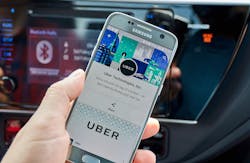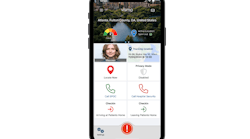Today, millions of callers pick up their smartphones to call for urgent assistance from first responders throughout the U.S. and Canada. For landline callers, emergency responders can be sent directly to the caller's house address based on their phone number in their moment of need, however much has changed over the past decade.
The greatest evolution of personal communications devices is the mobility offered, through their ability to connect wirelessly. However, with phone numbers and devices no longer being physically connected to a fixed point on the planet, the basic construct of using a telephone number for call routing becomes irrelevant. With 80 percent or more of all calls to 911 originating on the cellular network, this creates a dichotomy of functionality.
The Digital Revolution
Popular services like Uber have the ability to utilize location-based services through the use of an app. The smartphone device is very aware of its location, through the use of GPS, Wi-Fi BSS ID identifiers, as well as proximity to other known devices all being used as beacons. Applications running on the device contact one of several location services companies, and an approximate position along with a confidence factor is returned.
However, because 911 is a telephone call, there is no app. There is no ability to view the location-based parameters stored in the mobile device operating system. There is no way of communicating any information that may be available on the device to relevant parties. The only mode of communication is to transmit sound via an analog voice path. To send data, a data network must be present and functional element must exist to receive the data transmissions.
How High-Performance Enterprise Communications Solutions Can Help
Advancing emergency calling systems requires technology leaders with deep experience in building vast, quickly-emerging omnichannel systems for commercial communications environments. However, unfortunately to date, the mission has been very different. Most companies involved in Public Safety communications only deal with the audio of a phone call and the minimal data retrieved from the billing address associated with the phone number. New streams of additional data will now be present and available, and the systems to handle that information must be designed, implemented and maintained. While any mechanic can perform a tuneup on your Chevy pickup truck, you would arguably be more selective with your Tesla; that same logic applies here, the technology leaders advancing emergency calling systems must be experienced experts in this field.
As enterprise businesses fight for revenue and customer loyalty, they understand that multi-channel environments (voice, text, and email) are absolutely required, however, customers want to utilize these modalities in an omnichannel environment, where the modality of choice becomes the one that makes the most sense at the given time. It also means that a conversation starting out in one modality may escalate very quickly to another modality that is more appropriate for a particular conversation.
With multi-channel and omnichannel not available to 911, the nation, and the world are relegated to single mode voice communications. Avaya enables the world's largest and most critical networks and does this every day for the world’s largest airlines, banks, and online retailers. While the mission for a 911 call-taker is far more critical than commercial communications, the forensics, intelligence, and optimization that real-time communication companies like Avaya and others provide every day can bring a new level of resiliency, redundancy, and functionality to the public safety market, that has never been seen before.
A Rededication to Security
Security is the number one conversation that any enterprise business needs to have, whether they are a retailer, airline, or municipal government. So, it should come as no surprise that evolving and transforming the public safety market will also require a rededication to security. As the back end, emergency services network is IP-enabled, there is also an expansion of the attackable footprint. Security evaluation remediation is not a one-time event. Rather, it is an ongoing process that is constantly changing, learning and evolving as new threats become exposed.
A certain level of safety is offered in the legacy emergency network, however, because of its lack of IP connectivity there is a certain level of exposure – for example, a simple mass call event can have a crippling effect on the network (and in fact, it has before). In an IP environment, origination endpoint authentication is critical. Without a reliable identity method in place, the Internet would become the Wild West. In voice over IP telephony, that same construct applies.
The Future for First Responders
With the evolution of today's emergency network to one that is next-generation 911-enabled, and capable of handling additional modalities such as voice, video, and most importantly additional data from the Internet of Things, Public Safety has a unique opportunity to expand their visibility into incidents as they are unfolding.
Soon, first responders will be able to see temperature information from inside of a building with a fire or view real-time security video during a bank robbery. Biometric data from wearable devices will also increase the efficiency and capabilities of public safety agencies. In the near future, critical vital signs will be instantly available to remote staff at a hospital, allowing a targeted response by specific teams with the right gear for the mission at hand.
However, to make this future a reality, government must upgrade their existing legacy infrastructure. For example today, of the roughly one in five 911 centers that have adopted Text-to-911, most only allow for back-and-forth text, not giving people in emergency situations the ability to share their GPS coordinates or multimedia such as photos or videos that could help first responders assess the situation.
In an increasingly mobile world where Uber can locate and pick people up in less than 5 minutes, shouldn't our governments be making sure that our Emergency Services IP network is future-enabled, and that our first responders can find us when our lives are at risk?
About the Author:
Mark J. Fletcher is ENP, Chief Architect - Worldwide Public Safety Solutions Enterprise Solutions for Avaya.


